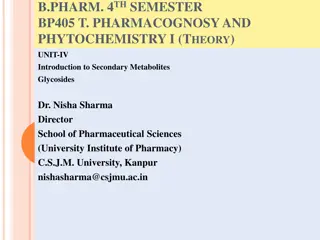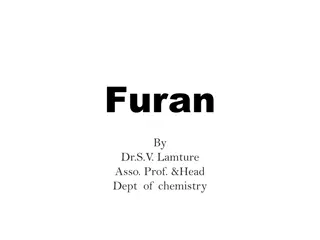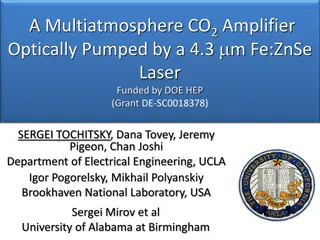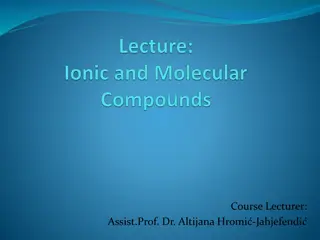Optical Properties of Optically Active Compounds
Circular dichroism and optical rotatory dispersion are important techniques for studying the optical properties of optically active compounds. Circular dichroism measures the differential absorption of left and right circularly polarized light components, while optical rotatory dispersion studies the change in optical rotation with wavelength. Different types of ORD curves exist, including simple and anomalous curves, providing valuable insights into the molecular structure of compounds.
Download Presentation

Please find below an Image/Link to download the presentation.
The content on the website is provided AS IS for your information and personal use only. It may not be sold, licensed, or shared on other websites without obtaining consent from the author.If you encounter any issues during the download, it is possible that the publisher has removed the file from their server.
You are allowed to download the files provided on this website for personal or commercial use, subject to the condition that they are used lawfully. All files are the property of their respective owners.
The content on the website is provided AS IS for your information and personal use only. It may not be sold, licensed, or shared on other websites without obtaining consent from the author.
E N D
Presentation Transcript
The measurement of unequal absorption of right and left circularly polarized components of a beam of linearly polarized light is known as circular dichroism. An optically active medium has unequal molar absorption co-efficients for left and right circularly polarized components. The difference in the molecular extinction co-efficients of the RCP and LCP rays ( ) is called differential dichroic absorption. This is illustrated in the following equation: = L- R O 1
The measurement of unequal absorption of right and left circularly polarized components of a beam of linearly polarized light is known as circular dichroism. An optically active medium has unequal molar absorption co-efficients for left and right circularly polarized components. The difference in the molecular extinction co-efficients of the RCP and LCP rays ( ) is called differential dichroic absorption. This is illustrated in the following equation: = L- R O 2
Circular dichroism is not easy to measure in the ultraviolet region, the only region where it can be important for colourless compounds, but the combination of circular dichroism and circular birefringence known as cotton effect, may be studied by plotting the change of optical rotation with wavelength. Such plots may now be obtained quite readily down to about 220 nm by means of photoelectric spectropolarimeters. For compounds that absorb only in the far ultraviolet, i.e. well below 220 nm, no cotton effect is observed precisely because the effect occurs only near an absorption maximum. 3
The measurement of optical rotation as a function of wavelength is known as Optical Rotatory Dispersion. It means, of course, that the method is applicable only to optically active compounds. Measurements are generally made in ultra violet/visible range where functional group of the compound under study has an absorption band with small extinction co-efficient. This makes the carbonyl group ideal for such studies and hence sample studies have been carried out with ketones. Types of optical rotatory dispersion curves There are two principal types of ORD curves : (i) simple ORD curves (ii) Anomalous ORD curves 4
Simple ORD Curves Simple ORD Curves may either be plain or normal dispersion curves. If measurement of rotation is restricted to wavelengths away from max region a solid curve results as shown in the Figure 6.5, showing a steady increase or decrease in optical rotation with decrease of wavelength. Such a plot is called plain curve. It may or may not cross zero rotation line but it is devoid of inflections or extrema. On the other hand, normal dispersion curve is one which is devoid of inflections, maxima or minima and crossings of zero rotation axis with in measureable range (Djerassi 1980 ) Figure 1 illustrates two simple ORD curves. 5
The curve A is referred to as the plain positive dispersion curve because the molecular rotation increases in the positive direction in going to shorter wavelength. The curve B is referred to as a plain negative dispersion curve ( molecular rotation increases in the negative direction ). The plain dispersion curve obeys a one term Drude equation, [( ) = K / ( 2 20) where K and 0 are empirical constants] and is a smooth curve,[ ] decreases (i.e. becoming less positive or negative ) as increases. is the wavelength at which the specific rotation is measured, 0 corresponds to the wavelength due to absorption maximum and K is the empirical constant. Anomalous ORD curves The ORD curves containing both the peak and the trough are called anomalous curves. The term anomalous is used because the curves do not obey the one term Drude equation. Anomalous curves are of two types: (i) Single cotton effect curves (ii) Multiple cotton effect curves 6
Single cotton effect curve Single cotton effect curves are defined as positive or negative, depending upon whether the peak occurs respectively at longer or shorter wavelength than the trough. The curve A in the Fig.6.6 is a positive single cotton effect curve. The various points on the curve are designated as peak (p) and the trough (T). The vertical distance a between the peak and trough is the amplitude and the horizontal distance b is the breadth. Multiple cotton effect curve A multiple cotton effect curve exhibits several peaks and troughs, with shoulders and inflections (Fig.6.6 ii) 7
THE AXIAL HALOKETONE RULE -halocyclohexanones exists primarily in an axial conformation in contrast to other -substituted cyclohexanones due to lesser unfavourable dipole dipole interactions, hence they give rise to relatively larger rotations, whereas other -substituted cyclohexanones give rise to no perceptible rotation since the substituent resides in the -plane. The axial haloketone rule applies to cyclohexanones containing an axial halogen (Cl, Br or I but not F due to low polarizability) next to the keto group. This rule may be regarded as the precursor of the more general octant rule. The rule states that the introduction of an equatorial halogen in either -position does not alter the sign of the cotton effect of the halogen free ketone, whereas the introduction of an axial halogen (Cl or Br) into the -position may alter the sign of the cotton effect of the parent ketone. When one looks along the O=C axis as indicated in the Fig.6.7, if the halogen is on the right, there will be a positive cotton effect and a negative cotton effect ,if the halogen is on the left. 8
The halogen (X) in the projected structure is in the lower right quadrant, a (+) sector and hence the cotton effect is +ve. In the enantiomeric structure, it would be in the lower left quadrant, a (-)sector, showing a negative cotton effect. The octant rule The octant rule was first formulated by Moffitt et al for correlation of the sign of the cotton effect of chiral cyclohexanone derivatives with their absolute configurations. The space around the carbonyl group is divided into eight sectors (octants) about the X, Y and Z axes with the help of three mutually perpendicular planes A,B and C defined by XY, ZY and XZ respectively. 9
The vertical plane A intersects the carbonyl oxygen and carbons 1 and 4 (bisects the cyclohexanone chair ). Plane B is perpendicular to plane A and contains C=O moiety and the two attached carbons C-2 and C-6. The plane C is perpendicular to both the planets A and B and intersects the carbon oxygen double bond at the midpoint. The two planes A and B thus divide the space around the carbonyl group into four quadrants designated as upper left (UL), upper right (UR), lower left (LL) and lower right (LR) and the groups in these four quadrants will contribute to the sign of the dispersion curve, as indicated by the plus and minus signs in the Fig.6.8. 10
These four quadrants constitute the set of the rear octants (away from the observer).On the left hand side of the plane C (not shown in the Fig.6.8), there is another set of four front quadrants which are mirror images of the former. Thus, the substituent's lying in the front quadrants contribute oppositely, i.e. their contribution to the sign of the cotton effect is exactly opposite to those shown in the Fig6.8 b. 11
The substituents, in the vast majority of substituted cyclohexanones, will appear only in the four rear quadrants and only rarely, a part of some molecules appears in the front quadrants. Therefore, for simple cyclohexanones, plane C may be ignored unless there are substituents to the left of it and only the four rear quadrants defined by planes A and B need to be considered. Contribution of substituents lying in the four rear octants towards the sign of the cotton effect is considered according to the following rules: (i) Substituent's lying in the coordinate planes A and B, do not contribute much to the cotton effect. This includes the 2e, 4a,4e and 6e bonds. (ii) Substituents lying in the (+) sectors (UL and LR) make a positive contribution and substituents lying in the (-) sectors (UR and LL) make a negative contribution to the cotton effect. Thus, the groups in upper left quadrant and axial groups in the lower right contribute to a positive cotton effect, and the groups in the upper right and the axial substituents in the lower left contribute to a negative cotton effect. The operation of the octant rule can be summarized as follows: 12
APPLICATIONS OF OCTANT RULE Determination of preferred conformation 3-methylcyclohexanone,known to have the R configuration, can be represented by the two conformers as shown in the Fig.6.9. 13
According to the octant rule, the equatorial conformer (a) should exhibit a positive cotton effect (3- Me is in the UL octant) while the axial conformer (b) would display a negative cotton effect (3-Me is in the UR octant). Since the ketone actually shows a positive cotton effect, the equatorial conformer predominates (consistent with the principle of conformational analysis). 14
Determination of conformation of (+) cis/trans -10-methyl -2-decalone 15
Determination of absolute configuration of (-) trans -1-decalone by application of axial haloketone rule Study of conformational changes In water (a solvent of high polarity), only a positive cotton effect is observed; in methanol (a solvent of moderate polarity) two cotton effects; one positive and the other negative appear; and in isooctane (a non polar solvent), the negative, cotton effect is very much pronounced. In solvents of intermediate polarity, both the cotton effects are seen in different proportions. This type of curve having two CD maxima of opposite signs is called bisignate. 16























